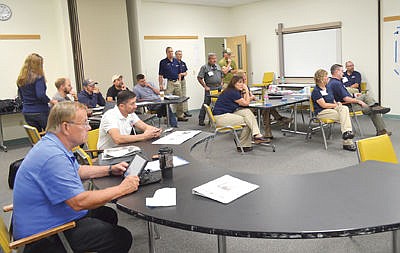Agencies gather for fire exercise
Seaborn Larson | Hagadone News Network | UPDATED 9 years, 4 months AGO
Local, state and agency officials met at the Kootenai National Forest Supervisor’s Office this week for an exercise in how to plan, approach and execute a coordinated effort in resolving a forest fire if a blaze were to ever come through Operable Unit 3, also known as the former W.R. Grace mine, which is still riddled with asbestos contaminants today.
The urgency and focus on the plan has been heightened during the last week, as large fires like the Roaring Lion Fire in Hamilton and the Copper King Fire each ripped through several thousand acres of Western Montana earlier this week.
The two-day exercise at the supervisor’s office essentially put representatives from all the agencies that would be involved in a OU3 firefighting effort, including Lincoln County, the State Department of Natural Resources and Conservation, the Department of Environmental Quality, the U.S. Forest Service and the Environmental Protection Agency, in the same room.
Agency officials hashed out the objectives, priorities and duties of each agency before working through a mock forest fire scenario in the OU3 area.
Canoe Gulch District Ranger Nate Gassman said it’s not if a fire ever reaches OU3, but when, and preparation for that time is instrumental in securing the safety for the Lincoln County public and firefighters tasked with the job.
“We know we’ll have a fire,” Gassmann said Wednesday after the exercise. “But there are things we’re doing to try to minimize and corral and control to get something out of this that’s less of an impact.”
Don Whittemore, an instructor for Mission-Centered Solutions in Colorado and the incident commander during last year’s Klatawa Fire that produced an evacuation near Libby, was the architect of the exercise and led the agencies through the two-day seminar.
“This exercise was designed to give them an opportunity to learn how effective that framework is in addressing a variety of situations that we presented,” Whittemore said. “It played out how I expected, in that their high-level thinking, the broad strategic vision, is solid. Now it’s getting down into some of the details.”
Whittemore said a successful fire management would primarily protect the health of the public and firefighters in the area, as well as keeping the fire small and quickly contained.
In short, the Forest Service is the lead agency on the ground, tasked with the initial fire attack. The Lincoln County Asbestos Resource Program, Health Department and public health officer will collect samples from the air and particulate matter and examine the data for asbestos contamination levels, along with the EPA and DEQ, who will in turn assist the county in making recommendations to the public based on the results.
“The county has an enormous role in successful management,” Whittemore said.
Asbestos Resource Program Manager Nick Raines said those recommendations would be based on state-established recommendations.
“They range in everything from ‘Go about your daily business as planned,’ to ‘We recommend limiting outdoor, high-exertion activities,’ all the way up to more stringent recommendations or higher recommendations of sheltering in place… based on levels of what we see in the ambient air.”
Raines said the program does have some limitations on how quickly monitoring capabilities can produce sampling results, so establishing routes to get information to the public beforehand is key in getting information out in a pace that fosters public safety.
“We’ll use a myriad of information dissemination options, from social media, to websites, to reader boards, newspaper, radio, television, any of our tools that we have available will be used for this type of an incident,” he said.
EPA Project Manager for OU3 Christina Progess said the federal agency would provide a support role to the unified command overseeing the incident if a fire were to reach the former mine site. That means using EPA resources to analyze asbestos samples from the county, evaluating the results and providing input on the recommendations made by the DEQ and county agencies.
For Progess, this week’s exercise has been a long time coming. The initial response plan was released mid-July but had been in the works for several months. In the response plan, the EPA has committed $300,000 to the preparation effort, which has an overall price tag of $2.1 million this year. That cost could increase or decrease depending on this year’s fire season results.
“We’ve come a long way,” she said. “This process started five months ago and to get where we are now is pretty impressive.”
The response plan also calls for a 10-person firefighting team to assemble near Libby for the single objective of being prepared for a fire in OU3. Since the plan was released, Gassmann said only half of that roster has been filled so far, with reluctance stemming from the asbestos contamination potentially compromising firefighter health.
“We’ve got five dedicated to the effort. We’ve got other contracts out there for heavy equipment and those sorts of things but it’s hard to generate a big support for this knowing all the added elements that go into it,” he said.
Gassmann said through the initial year of the OU3 fire plan, he hopes agencies will be able to collect more data and shed more light on the actual hazards associated with fighting a fire in the area.
“We’re already starting to figure out where to go next for next year and years beyond, to try to eliminate some of those question marks.”
And as the OU3 fire scenario presents an unprecedented toxic threat to the area, Gassmann said the agencies involved are not necessarily going in, or coming out of this exercise blind.
“There’s been a lot of other efforts nationally and internationally that deal with emergency responses and we draw from that expertise. We need to apply that knowledge as it relates to the asbestos question,” he said.
After the exercise concluded on Wednesday, agency officials said the next step is to scope in on the smaller details of the response plan. As agencies work to perfect their efforts in the overall objective, Progess said representatives will likely reconvene again to complete exercises on the small-scale workings of the plan.
“This exercise was a high-level overview of the plan,” she said. “Now we’re going to be drilling down to fill those gaps.”
“It’s like any sports team; when you run through practice and identify where you’re strong and start to realize where you’re weak and that’s what this provided to us,” Gassmann said. “It’s a complex issue but when you boil down to some of the basic elements it’s about public and fire fighter safety.”
Reporter Seaborn Larson may be reached at 758-4441 or by email at [email protected].
ARTICLES BY SEABORN LARSON
Flathead Bank acquired by First Interstate
First Interstate Bank on Wednesday announced it is buying Flathead Bank for $34.2 million in cash.

HUTTON HOEDOWN: History revived through family reunion






